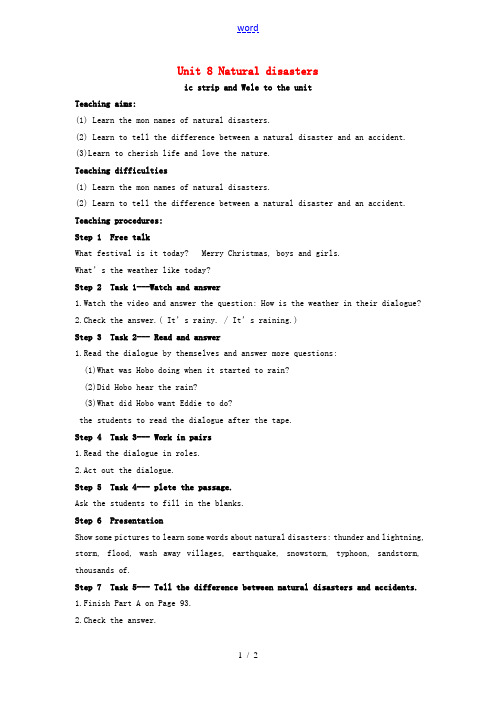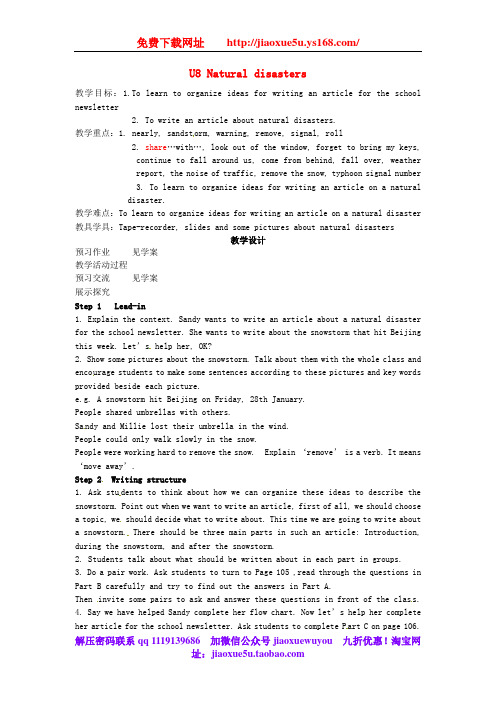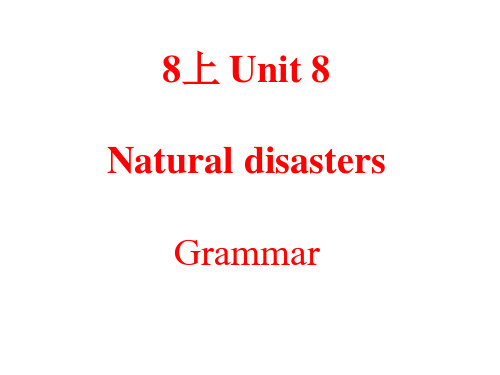江苏省永丰初级中学八年级英语上册 Unit 8 Natural disasters Welcome
- 格式:ppt
- 大小:11.77 MB
- 文档页数:38
![[中学联盟]江苏省永丰初级中学八年级英语上册unit8 comic strip welcome to the unit](https://img.taocdn.com/s1/m/5a4ddbfc26fff705cc170a99.png)

免费下载网址/Unit 8 Natural disasters ( Vocabulary) Period 4教学目标: 1. To learn how to change nouns to adjectives.2. To learn to use the words and phrases to describe weather conditions .3. To get the students to make a weather forecast.教学重点: 1. Key words& phrases: cloud, wind, windy, weather, temperature, low,drop a little, become worse.2. How to change nouns to adjectives and use the words and phrases todescribe weather conditions .教学难点: To get the useful information of the te xt, and make a weather forecast .教具学具: Multi-media教学设计一.预习作业Ⅰ) 请学生初步了解并熟读本课时的词汇,再完成以下练习(英汉互译)1. cloud2. wind3. windy4. weather5. temperature6. low7. 雾 8. 有雾的9. 霜 10.有霜的Ⅱ) Underline and tell the Chinese meaning(在书上划下来并翻译)1. drop a little2. become worse3. the weather todayⅢ)自主探究,请带着下面的问题阅读教材。
你能分别说出的cloud, snow, storm的形容词形式吗?二.教学过程Ⅰ.预习交流Free talk and check the preparation out.1.Show some pictures of natural disasters, review the disasters we havelearnt. (thunder& lightning, forest fire, rainstorm, snowstorm)2. Check out the prepared work.A.单词和词组,个别读且纠正----集体教学朗读----提示重点单词B.cloud, snow, storm的形容词形式,小组核对----集体校对----质疑交流Ⅱ. 展示探究Step One: Presentation1.S how some pictures of weather conditions and ask: What’s theweather like ? / How’s the weather ?(It’s rainy/ sunny/ windy/ stormy/ cloudy/ foggy/ snowy/frosty/cold. )2.W rite down the new words on the blackboard, read, understandand learn them by heart.Step Two: Cooperative study合作探究1.A sk the students to work in pairs and work out the rules .Change the nouns into adjectives. We put a “y” or “double解压密码联系qq 1119139686 加微信公众号jiaoxuewuyou 九折优惠!淘宝网consonant + y” after the noun .2.P ractice :Ask the students to write the correct adjectives in the blanksNoun AdjectivesuncloudywindrainfoggysnowfroststormyStep Three: Self-study自主研习1) Finish Part A on the book at P982) Complete the following exercises①The story happened on a cold (snow) morning.②The river is a (nature) waterway, notman-made.③It is going to be (wind) tonight. T he wind willblow(strong).④The weather will become (bad) on Monday thantoday.⑤Did you feel the (shake) of the earthquake ?3) Check the answers .S tep Four: Show Feedback展示反馈1) Finish Part B on the book at P982) around/above /below 7℃意思是drop to: 意思是-5℃意思是读作3) Read and act out Part B.4) Use the weather forecast to make a weather report in groups.星期三星期四星期五星期六5℃~20℃7℃~18℃ 3℃~4℃ -3℃~0℃晴雨多云雪旅游指数:洗车指数:感冒指数:舒适度:较适宜…不适宜…较易…感觉冷…Ⅲ. 检测反馈一.单词填空。

Unit 8一、用↗(升调)或↘(降调)标出下列句子的语调_______ 1. Who saw the accident first?_______ 2. It is really a wonderful place to visit._______ 3. The shopping mall is open at 8:30 every day._______ 4. Can you show us the photos of the trip?_______ 5. I don’t know the way to the police station._______ 6. Is there anything strange in the bushes?_______ 7.------ There are over twenty persons killed in the earthquake._______ ------ Twenty persons._______ 8. When will you go there?_______ 9. Did the police catch the robbers?_______ 10.Help, help. I’m here.二、选择题1. The Zhalong Nature Reserve is an important area of the rare redcrowned cranes.A. livingB. livelyC. aliveD. lovely2. Our team played badly at first got better in the second half.3. Be careful . There are here.A. piece of glassesB. pieces of glassesC. piece of glassD. pieces of glass4. ----- ?------It’s rainy.A. How’s the weatherB. What do you think of itC. What does it look likeD. Who’s this5. ------What do you think ofMr Li’s teaching?------Oh , no one teaches than him.A. wellB. betterC. bestD. good三、句型转换1. We are all from the south of China.(改为一般疑问句)2. He likes playing softball. (改为一般疑问句)3. Yesterday we visited the Monument to the People’s Heroes. (改为一般疑问句)4. A car hit him a moment ago.(对划线部分提问)5. There is only one student in the classroom. (对划线部分提问)6. The students usually have lessons five days a week. (对划线部分提问)7. My home is about 2 kilometres from the school. (对划线部分提问)8. My friend asked me to help him with his English. (对划线部分提问)四.根据汉语提示完成句子1. 没有人能够回答这个问题。

Unit 8 Natural disastersic strip and Wele to the unitTeaching aims:(1) Learn the mon names of natural disasters.(2) Learn to tell the difference between a natural disaster and an accident.(3)Learn to cherish life and love the nature.Teaching difficulties(1) Learn the mon names of natural disasters.(2) Learn to tell the difference between a natural disaster and an accident. Teaching procedures:Step 1 Free talkWhat festival is it today? Merry Christmas, boys and girls.What’s the weather like today?Step 2 Task 1---Watch and answer1.Watch the video and answer the question: How is the weather in their dialogue?2.Check the answer.( It’s rainy. / It’s raining.)Step 3 Task 2--- Read and answer1.Read the dialogue by themselves and answer more questions:(1)What was Hobo doing when it started to rain?(2)Did Hobo hear the rain?(3)What did Hobo want Eddie to do?the students to read the dialogue after the tape.Step 4 Task 3--- Work in pairs1.Read the dialogue in roles.2.Act out the dialogue.Step 5 Task 4--- plete the passage.Ask the students to fill in the blanks.Step 6 PresentationShow some pictures to learn some words about natural disasters: thunder and lightning, storm, flood, wash away villages, earthquake, snowstorm, typhoon, sandstorm, thousands of.Step 7 Task 5--- Tell the difference between natural disasters and accidents.1.Finish Part A on Page 93.2.Check the answer.Step 8 Task 6--- Listen and read1.Listen to the tape and fill in the blanks.2.Read the conversation after the teacher.Step 9 Task 7--- Group work1.Ask the students to make a new dialogue with their partner.2.Show their dialogues.Step 10 Discussion1.If the fire happened in the daytime, can you guess the result?2.If natural disasters happen, what should you do?Keep calm.Don’t worry.Shout for help.Call 119, 110, 120…Cover your mouth and nose with a wet towel.…Step 11 SummaryMake a summary about what we have learnt today.Step 12 Do some exercisesAsk the students to finish some exercise.Step 13 Homework1.Prepare for the reading part.2.Finish some exercises.。

免费下载网址/U8 Natural disasters教学目标:1.To learn to organize ideas for writing an article for the school newsletter2. To write an article about natural disasters.教学重点:1. nearly, sandst orm, warning, remove, signal, roll2. share…with…, look out of the window, forget to bring my keys,continue to fall around us, come from behind, fall over, weatherreport, the noise of traffic, remove the snow, typhoon signal number3. To learn to organize ideas for writing an article on a naturaldisaster.教学难点:To learn to organize ideas for writing an article on a natural disaster 教具学具:Tape-recorder, slides and some pictures about natural disasters教学设计预习作业见学案教学活动过程预习交流见学案展示探究Step 1 Lead-in1. Explain the context. Sandy wants to write an article about a natural disaster for the school newsletter. She wants to write about the snowstorm that hit Beijing this week. Let’s help her, OK?2. Show some pictures about the snowstorm. Talk about them with the whole class and encourage students to make some sentences according to these pictures and key words provided beside each picture.e.g. A snowstorm hit Beijing on Friday, 28th January.People shared umbrellas with others.Sa ndy and Millie lost their umbrella in the wind.People could only walk slowly in the snow.People were working hard to remove the snow. Explain ‘remove’ is a verb. It means ‘move away’.Step 2 Writing structure1. Ask stu dents to think about how we can organize these ideas to describe the snowstorm. Point out when we want to write an article, first of all, we should choose a topic, we should decide what to write about. This time we are going to write about a snowstorm. There should be three main parts in such an article: Introduction, during the snowstorm, and after the snowstorm.2. Students talk about what should be written about in each part in groups.3. Do a pair work. Ask students to turn to Page 105 ,read through the questions in Part B carefully and try to find out the answers in Part A.Then invite some pairs to ask and answer these questions in front of the clas s.4. Say we have helped Sandy complete her flow chart. Now let’s help her complete her article for the school newsletter. Ask students to complete P art C on page 106. 解压密码联系qq 1119139686 加微信公众号jiaoxuewuyou 九折优惠!淘宝网址:5. Analyze the structure of this article with the whole class. Then make a conclusion: Para 1 is the introduction of the snowstorm. Para2 and 3 describe what happened during the snowstorm. And Para 4 describes what happened after the snowstorm.当堂检测Step 3 Practice1. Say we have helped Sandy complete an article about a snowstorm. A sk students to write an article about a natural disaster by themselves2. Ask students to work in groups of four. First, each group chooses a topic to write about. Then talk in groups. Next, Sort out their notes into a flow chart as in Part B. Last, discuss their notes with others and share their flow chart with their group membe rs.3. Ask some individuals to show his/her flow chart and talk about it with the whole class.4. Students complete their articles.。

Unit 8Natural disasters教案ic strip and wele to the unitTeaching Aims:1. To learn the new words and phrases2. To meet the past continuous tense3. Talk about some natural disaster.Step 1 Presentation1. Show some pictures to learn some words.2. Then read aloud the new words.disaster mop up earthquake thousands of accident coach crash flood wash away village lightning storm thunder catch fire Step 2Do some exercises.Do Part A on page 93.Check the answers.Step3 PresentationShow some pictures to present ic strip.Step 4 Listen and answer1. Listen to the tape and answer the follow questions.1)What’s the weather like?2)What happened to Hobo?3)What was Hobo doing when it started to rain?4) Did Hobo hear the rain?5)Why doesn’t he want to go home alone?6)What do you think of Hobo?2. Read the dialogue in pairs.3. Act it out.Step6 Listening1.Listen to part B and answer the following question.1) What happened to Vivi en’s school?2)When did it happen?2.Read after the recorder.3.Pratice in pairs.4.Act it out.5.Make their own dialogue.Step 7 Explanation1. wake up 醒过wake sb. up 叫醒某人e.g. I wake up at six every morning!我每天早上六点钟醒来。
NO.57课题:8A Unit 8 Natural disasters,Comic strips & Welcome to the Unit主备人:审核人:一、教学重点:Get to know how to use adjective to describe natural disasters and bad weather.二、教学难点:Get more students to tell a natural disaster they know about.三、教学过程:【预习检查】写出下列词语1.把...拖洗干净____________ 2.输掉比赛____________3.杀死成千上万的人____________ 4.他的腿受了伤____________5.把村子冲走____________ 6.雷电____________【目标展示】1. To introduce the topic of disasters2. To activate existing knowledge of the world in response to newspaper headlines3. To identify vocabulary related to the topic4. To guess meaning from keywords5. To identify weather conditions and label pictures with correct words【新知研习】研习1:熟读漫画Eddie and Hobo 的对话,并回答下列问题。
1. What’s the weather like today?2. What’s happened to Hobo?3. What was Hobo doing when it started to rain?4. How does he feel at Eddie’s home?5. What happened to Hobo’s house?6. Why doesn’t he want to go home alone?B部分。
课题8上Unit 8 Task 课型Revisi on To plan ideas for writing教学目标To learn the proper and easy ways to write something;教学重点To write a description of the disasters教学难点To generate personal ideas, plan and organize text to express one's own opinions教学过程教师内容备课札记温故知新导引自学Step 1 预习作业检测Check out the pre-exercises交流质疑精讲点拨Step 2 Talking about picturesShow a picture of a snowstorm and get the students to talk about it.Step 3 Writing an arti cle about a n atural disasterExplain that Sandy wants to write an article about a naturaldisaster. Write the following sentences on the board beforehandwit h blanks.Get the students to fill in the bl anks. In this ways, they can getsome idea about what sandy saw, what she heard and how she felt.Get the students to read the sentences one by one. Motiva te thestudents to read it aloud.Step 4 Making a flow chartTell the students that Sandy also makes a flow chart to organize herideas. Divide the students into groups of 4. Invite the students tohelp Sandy complete the flow chart. Then ask them to discuss theanswers in groups of 4. Check the answers.Direct students’ attention to the way that the flow chart wasorganized. Point out that introduction gives us some facts.Then Sandy is goi ng to talk about the things t hat happened duringthe snowstorm and then after the storm.S andy tells us what she saw, what she hear and how she felt during and after the snowstorm.After this it is important to point out that to organize the ideas will help people who are telling a personal story. It is also very important for the speaker to c onsider of the audience.Step 5 Completing the sample articleGive the students 4-5 minute to complete the s ample article. And then check the answers to it.Get the students to figure out the structure of the article.Step 6 Locating some important sentence patternsGo through the article and help the students to locate some important sentenc e patterns.I looked out of the window and saw that people were working hard to remove the snow.当堂反馈拓展迁移Step 7 Homework1.Remember the words, phras es and sentences.2.Read and recite sample writing.3.Write a passage about your ideal school.板书设计。